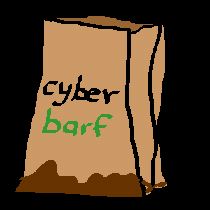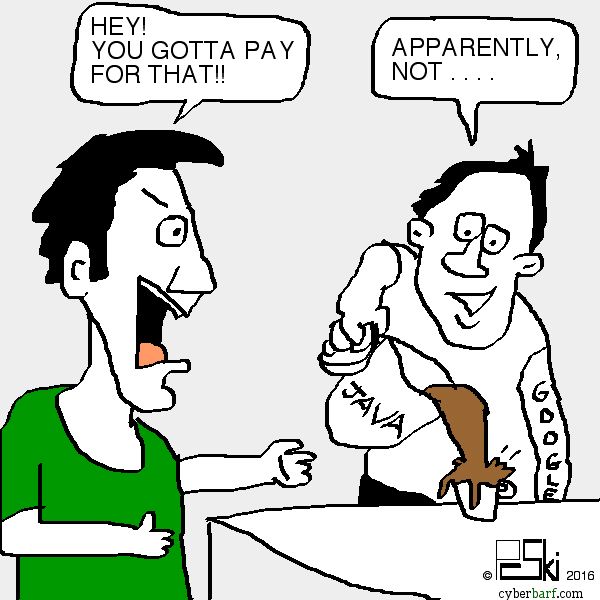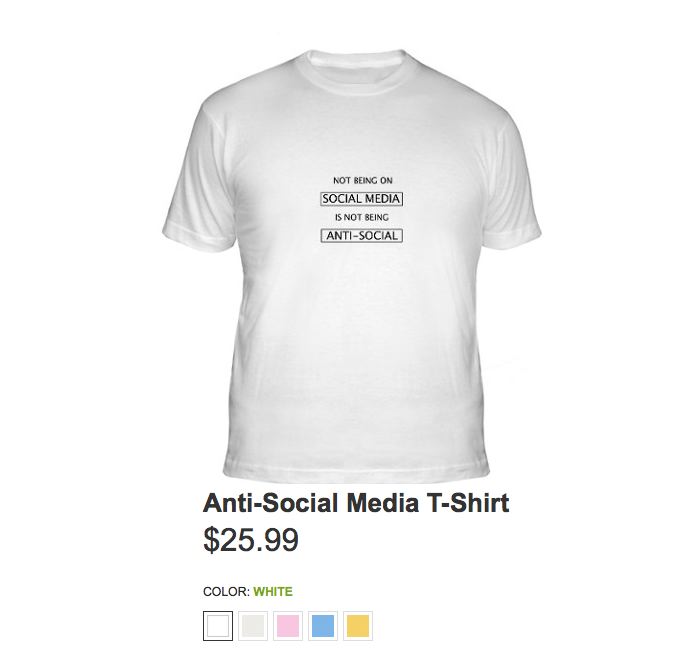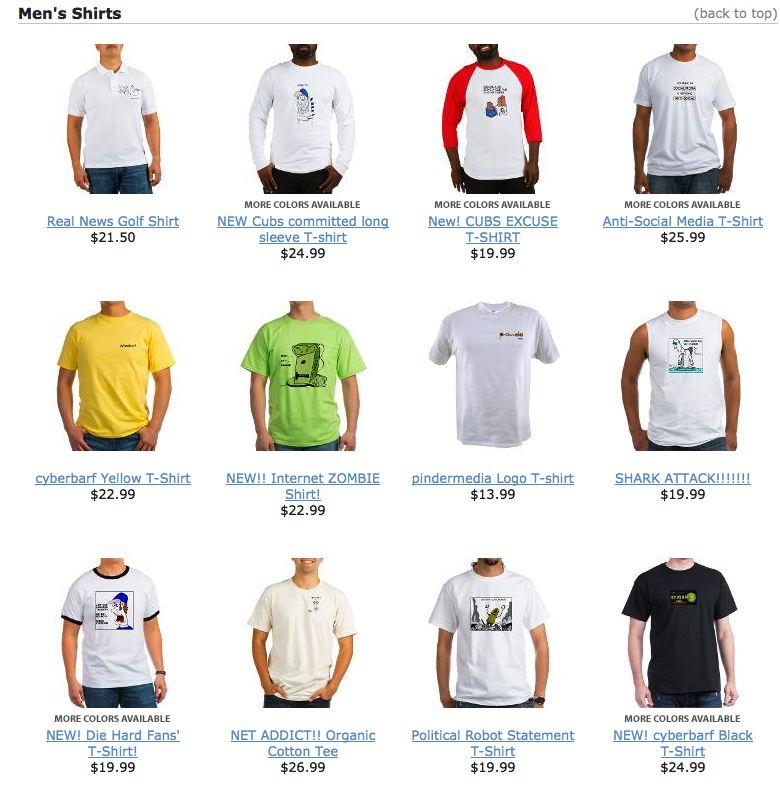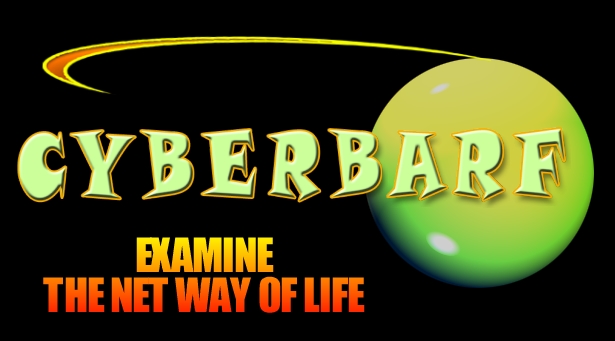|
cyberbarf VOLUME 15 NO. 11 EXAMINE THE NET WAY OF LIFE JUNE, 2016 ©2016 Ski Words, Cartoons & Illustrations All Rights Reserved Worldwide Distributed by pindermedia.com, inc. |
|
|
“Look on the Bright Side of Life.” - - - Monty Python IN THIS ISSUE: LENO CYBERSECURITY WHETHER REPORT iTOONS
NEW EPISODE:
|
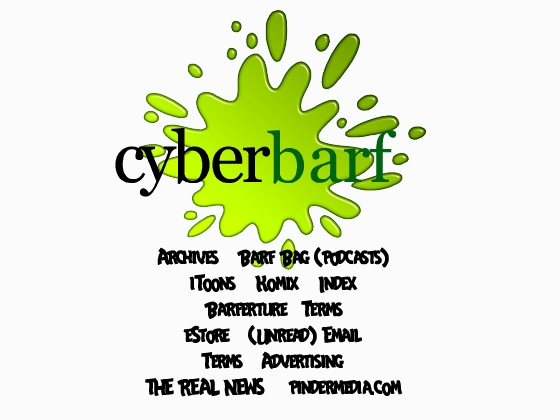 |
|
cyberbarf LENO REVIEW In 1992, comedian Jay Leno got the pinnacle of his profession when he was named the new host of NBC's Tonight Show. The late night talk show had been an NBC staple and huge money maker. Leno's new role set off what historians would call The Late Night Wars with jilted David Letterman starting a new show on CBS and ABC elevating Jimmy Kimmel to the competition. Leno had been a guest host in the past. But his selection as the permanent replacement for the legendary Johnny Carson was a surprise because Leno folksy humor did not make him a good interviewer. He could do an opening monologue but his interviews with celebrities were not earth shattering (until he got the first Hugh Grant interview after his public faux pas.) Leno was a safe programming choice: he was steady, hard working, easy going, noncontroversial and the affiliates loved him because he would do dozens of events for them. Leno was a good company man. Leno's Tonight Show run made him a wealthy man. But throughout his long stand-up career, Leno had another passion: automobiles. When he had enough money, he began collecting cars from his childhood. After his retirement from NBC, he continued to dabble in his hobby-passion-obsession. He has collected a mass array of unusual, expensive and strange vehicles. Last year, his impressive collection and his personality allowed him to return to television with a new cable show, Jay Leno's Garage. In any episode, you can find Leno showing off one of his rare cars, driving them through California. He would also educate, enlighten and entertain viewers on car culture, something that may be waning with the next generation. Leno is a car collector, a car restorer and a car historian. He has an encyclopedia knowledge of cars, their components, their backstories and their innovation. He knows his stuff in a non-stuffy way. He wants to show the public what drives him in his retirement. As with any collector, he gets a kick at showing off his valuables but also educating others on why he finds this a rewarding adventure. Leno's show came out of nowhere to fill a gearhead void. The most popular car show on the planet was BBC's Top Gear. A normal auto review program was rebooted in 2002 by an acerbic host, auto writer Jeremy Clarkson, and his co-hosts Richard Hammond and James May. The new Top Gear exploded into a world wide hit. It was syndicated and seen weekly by approximately 350 million people. They were not politically correct, they tore up tires like kids eating Halloween candy, and traveled the globe filming stunning visuals which featured cars. Some of the best travel programs were their epic specials: driving motorcycles the length of Vietnam; driving work trucks through Burma to Thailand to build a bridge over a river; driving the first motorized vehicle to the North Pole; and an African safari for the search of the source of the River Nile. Leno himself actually appeared on Top Gear's segment, A Star in a Reasonably Priced Car. The idea was to have celebrities come in to the studio to talk about their car history (good or bad) and then have them race an average car around a test track. Since British cars have their steering wheel on the wrong side as Leno quipped, he said he was a fan of the show. There is a fraternity between American gearheads like Leno with their British counterpart petroheads. But just as the Clarkson-Hammond-May show was about to be renewed, Clarkson had a physical confrontation with a segment producer which resulted in a serious breach of BBC standards. Even though Clarkson had had run-ins with the public trust broadcaster, this physical abuse was the final straw. The hosts contracts were not renewed and the auto world was thrown into a tizzy. The BBC was also reeling from the incident. Top Gear was the most profitable show it had in its schedule. It's revenue could not be replaced with normal programming because of Top Gear's global brand. So the BBC had to re-boot the show for a third time. They chose a known petrohead radio DJ named Chris Evans to front the new Top Gear. They also surprisingly hired American Matt LeBlanc (from Friends) to be his co-host. LeBlanc was the fastest celebrity to drive on the old Top Gear track. The BBC hopes that the fusion of a British and American love of cars will right the listing franchise. So Leno's new car show immediately filled a critical void in car porn market. There are many other consumer car programs on television, but Leno's formula for his show began as doing YouTube style videos of what he was up to in his garage; what was the state of a current restoration or a new barn find (an abandoned, rusted or neglected classic car to be salvaged and saved). But Leno developed quickly into a broader but defined entertainment program. While his audience is small since the show is broadcast on a financial cable channel, CNBC, a Memorial Day marathon binge view showed that Leno is a personable host on a cleverly constructed hour program. He did overlap on some of the Top Gear bits, such as racing a tank with one of his hot rods (one which was built with a tank motor). But he also had segments about car culture: how guys make hot rods; a young woman who drag races top fuel cars; to Latino low riders; to a real classic San Francisco motorcycle club which is not an outlaw biker gang. And he is smart enough to seek out the future with a long segment on high school and college students building vehicles that can get 500 miles per gallon. Leno told them that he believed that engineers are the future on mankind. He also tackled current subjects like self-driving cars. But his real passion and sparkle is driving unusual or beautiful cars. Leno has enough clout to get rare access into the Presidential motor vehicle garage to see all the bulletproof limos. He also got rare access to the vault of the Petersen Auto Museum in LA. But one moment you could tell thrilled Jay to no end was driving the previously unseen General Motors Pegasus. The Pegasus was a design concept car that GM built to kick start a more European design element in their production vehicles. The Pegasus was unique because GM chief designer put in a Ferrari engine into a modified Pontiac body and chassis. The GM board was not pleased with it having a non-GM engine so the Pegasus was put into storage never to see the light of day. Jay Leno's Garage has all the elements of a good television program: an easy going highly informed host, vehicle eye candy for gearheads, interesting stories from the Model T to today's performance hybrids, and information for potential car collectors. In one way, Leno's program is more car centric than the old Top Gear, or the new Clarkson-Hammond-May Amazon car show called The Grand Tour (which is a late 19th century British saying for young lads upon graduation for school would get a sponsor so they could travel throughout Europe, Africa and the colonies to learn about the world, life and women.) The world could soon have three well-produced and entertaining automobile programs with Jay Leno's Garage, the new Top Gear and The Grand Tour. But the irony of this Golden Age of Motoring Television is that the Millennial generation seems to have no interest in automobiles or car culture. They are not interested in getting their driver's licenses at age 16, or buying a car, or living in the suburbs (unless it is in their parents basement.) The next generation who will be saddled with educational debt finds the sharing economy of Uber or Lyft services more appealing than racing down a mountain road in a rag top sports car or tearing up the beach sand in a dune buggy. But anyone who likes history, pop culture, innovation and art of mechanical engineering should watch Leno's program. Jay Leno's Garage returns for its second season on June 15, 2016 on CNBC. |
It continues to be silly that Wall Street analysts continue to rail against Apple as not being an innovative leader in technology. Stock players ripped Apple's last quarter and forced the stock price down almost 20 percent even though the company made $10.25 billion in quarterly profits. But no other company in the planet generates as much profits than Apple. It must be doing something right.
Facebook was accused of having a liberal bias in terms of listing its trending stories on users time lines. Facebook is a private company which can do whatever political speech it wants to do. The complaints center around the potential issue of blocking conservative content from users who are actually conservative or open minded in their political views. If Facebook is an open community, then it should allow access to all political ideas. But this story does show that the distributor of information can actually control the actual information and users may not be consciously aware of it.
The self-driving car craze is getting more serious with the rise of the autonomous tractor trailer trucks. These semis transport much of the goods to your local retailers. The concept of large trucks driving themselves on the interstates or local highways is a serious concern because of potential destructive power of these huge rigs and possible dangerous cargo. Even railroads have engineers at the helm of their locomotives even though much of the driving of the train is automatic. The reason is simple: a human being is needed to override the controls to make sure safety is the key. A train is set on its own tracks while a truck is on the crowded public highways. A train has interaction with the unpredictable work at track crossings while trucks have to deal with distracted, drunk or erratic vehicles on any road or road surface. The reason why business is intrigued by the idea of driverless vehicles is cost savings. The idea of removing a highly paid union truck driver with a programmable computer seems to be potential revenue savings profit center. But at what cost to the other road drivers?
Fans will be fans. Die hard X-Files fans like the rebooted disjointed mini-series. The idea of having a cliffhanger ending without a network commitment for a second season was a little too bold for some people. There is a current wave of nostalgic programs returning to the networks. There is an old adage that there is nothing new in Hollywood. That the industry has run out of ideas but still has hundreds of hours to fill with something. Producers hope that old shows still have a built in audience that wants to see their favorite show return. It can be sold easier than a new concept with a new cast of characters. Most pilots never make it to air. New old shows are trying to buck that trend by putting familiar faces back on screen. |
|
cyberbarf CYBERSECURITY ARTICLE For at least the second time, evidence in a child pornography case has been thrown out because the US government refuses to detail how it hacked the website allegedly visited by the defendant, reports CNET. The FBI says the hacking method, referred to as a Network Investigation Technique, or NIT, allowed the bureau to track defendant Jay Michaud after he visited a hidden website on the so-called Dark Web. The FBI investigation led to charges of possessing child pornography. However, defense attorneys asked the court for the methods of how the FBI collected the information to determine if it was reliable (since the Dark Web has many ways to hide who is behind information) and whether the FBI violated any constitutional rights such as searching without a warrant. The attorneys said a government explanation could show that the method yielded unreliable information or that the defendant's computer inadvertenly stored such images as a result of malware and not actual intent by the defendant. The FBI refused to answer how it came to the information on defendant's case, so the judge threw out any evidence used in that part of the investigation (and basically ending the case). The Associated Press has reported about cases in which child pornography was found stashed on the hacked computers of innocent people. Defense attorneys have been getting aggressive on learning how FBI gets its computer information in cases. The case is part of a growing debate over government hacking in criminal cases. The FBI/Justice Department went after Apple to have it create a back door key for its iOS phone systems so investigators could unlock terrorist and criminal cell phones. Apple refused. As the case was coming to a head, the FBI and DOJ dropped the subpoena against Apple. It said it found a hack into the phone, but refused to disclose what, if any, information was found. It was reported that that the FBI may have purchased a hacking program from a foreign security company. The cost of such software ran from $15,000 to $ 1 million. The problem with bringing hackers to justice is that they are extremely clever. They use software programs that disguise their location, their IP addresses, their router information and their encrypted monetary trails. In order to find hackers, police investigators have to think like hackers. They have to worm their way into hacking communities in order to learn current secrets. They have to act like hackers which can create a serious legal problem. If the police have to break the law in order to capture a criminal, is that right? Hackers are getting more brazen. Stealing credit card information and selling personal information on the black market has been the bread and butter scams for hackers. But now a more aggressive form of hacking, ransomware, has been hitting major institutions like hospitals who have very sensitive and important patient data bases. Several hospitals have confirmed in the last year that hackers seized control of their servers and froze out administrators. The hackers demanded a ransom to release the data back. Some hospitals complied by paying the required tribute (usually through untraceable bitcoin payments). However, negotiating with criminals does not always work out, as Kansas Heart Hospital in Wichita learned last month. It paid hackers to get files back after falling victim to ransomware, but only got only partial access and a demand for more money, Techspot reported. The hospital's president refused to pay a second ransom. Hospitals are under severe regulatory pressure under HIPPA to safeguard patient information. But hospitals are large institutions, usually part of larger health care networks, which rely upon internet and the cloud to move and store files. Any person who uses the net is weak to an attack. Many hospitals use older systems which may have known security flaws that can be easily exploited by hackers. This is why cybersecurity is a growing field. The risk of losing all a company's proprietary data is a daunting task that most insurance policies will not cover without an expensive, special endorsement rider. Risk management procedures now are written to cover cyberattack responses as well as normal power failures, weather damage, internal theft and terror attacks. The only thing that can insure a company from being trapped in a ransomware event is to have a secure, off-site, non-connected back up of all the information and programs it uses. But this is an expensive and time consuming procedure to maintain. And it is the maintenance of security protocols is where hackers can get into the company computers. Security specialists state that the most common breach comes from lax employee awareness. Phishing schemes and email clicks (that look official from a DFO or executive) that infect the administration codes are still common place. An employee that misplaces a laptop or company cell phone gives a hacker the means to get inside. And there is always the disgruntled employee who is willing to get some pay back. Hackers are full time code breakers. As such, there is a parallel gray market of hackers who find holes in security then sell their findings to computer firms. These zero-day payments are independent, freelance security patches that many software giants have to keep in mind when they release every update. But you have the white knights who are security firms that want to find and block software flaws to keep criminals from doing their nasty intrusions. But there is also the gray market guys who sit on the fence between good and evil - - - and sell their findings to either the hacked company or to the criminal hacking community. And then there is the dark knights, hackers who are hired to find backdoors, keys or brute force techniques to spy on secured systems. The latter may be the proving grounds for the latest government techniques against encrypted foreign governments and Apple phones. The stakes are growing higher. In Japan, there was a recent ATM heist involving 1,400 machines in convenience stores. The scam resulted in the loss of 1.4 billion yen ($12.7 million). The theft took place in the early hours of Sunday morning, May 15, 2016 across Tokyo and 16 other prefectures in the country. Police said they believe up to 100 people were involved in the heist, according to the Kyodo News Agency. The thieves apparently went to ATMs like those found in 7-11s across Japan and swiped counterfeit South African credit cards, created using information from cards issued by South Africa's Standard Bank. At each of the approximately 1,400 ATMs that were struck, the culprit withdrew 100,000 yen (about $900), which is the maximum withdrawal permitted on the machines. According to Reuters Africa, Standard Bank is estimating its total losses at 300 million rand ($19 million) prior to any potential recoveries that may serve to reduce the loss. The Japan ATM attack shows the sophistication of international criminal networks. It exploited a lax South African bank. It stole credit card information. It sent the data to Japan where 100 criminals in concert stole at least $1.27 million each during the three hour crime spree. That has to rank as one of the highest in-person robberies of all time. The reaction to the massive heist made credit card networks like Visa and MasterCard praising their move toward uniform acceptance of chip-based cards, which are considered less vulnerable to fraud than magnetic stripe cards. However, it is a just a matter of time before the hackers find a way to break into the chip-and-pin security features of the new cards. With the magnetic swipe technology, police in the US released security camera footage of two men going into a convenience store. One man distracts the store clerk with a purchase of something on the wall behind the counter. The other man takes a card reader out of his knap sack and presses it down over the current store reader. It looks exactly the same as the old model but it is an over shell that reads and stores every credit card swipe made at that terminal. The store is unaware that there is a theft device on their credit card machine. One lesson learned in recent news stories is that a person or company cannot rely upon other people to protect their data and personal identity. Everyone needs to educate themselves on the risks associated with private information as it wanders around in public spaces. Cybersecurity specialists will continue to try to educate, patch and help stem the tide of cybercriminals but it may be like baling water in a leaky boat. |
 |
|
cyberbarf THE WHETHER REPORT |
cyberbarf STATUS |
| Question: Whether the FBI's withdrawal of its demand for Apple to create a back door key for iPhones signals a defeat in its encryption war? |
* Educated Guess * Possible * Probable * Beyond a Reasonable Doubt * Doubtful * Vapor Dream |
| Question: Whether high frequency stock speed trades (using computers to use microsecond buy/sell orders) will be regulated out of existence? |
* Educated Guess * Possible * Probable * Beyond a Reasonable Doubt * Doubtful * Vapor Dream |
| Question: Whether China's recent bans on Apple music, iTunes and Disney works harbors a major reversal in attitude toward Western Culture in its culture? |
* Educated Guess * Possible * Probable * Beyond a Reasonable Doubt * Doubtful * Vapor Dream |
|
cyberbarf EXAMINE THE NET WAY OF LIFE iToons
|
|
LADIES' JAMS MULTIPLE STYLES-COLORS $31.99 PRICES TO SUBJECT TO CHANGE PLEASE REVIEW E-STORE SITE FOR CURRENT SALES
|
PRICES SUBJECT TO CHANGE; PLEASE CHECK STORE THANK YOU FOR YOUR SUPPORT!
NEW REAL NEWS KOMIX! SHOW HACK! |
|
PRICES TO SUBJECT TO CHANGE PLEASE REVIEW E-STORE SITE FOR CURRENT SALES & CURRENT STYLES
|
|
THE PINDERMEDIA STORE IS FULL OF FUN T-SHIRTS CLOTHES, HATS AND OTHER ITEMS. CHECK OUT THE STORE FOR ITEMS
SUPPORT cyberbarf VISIT THE CYBERBARF STORE! Prices and styles may vary depending on sales, allotments, inventory. |
|
BACK IN BLACK WITH THIS CLASSIC CYBERBARF T-SHIRT!
FEATURING: THE REAL NEWS IMPACT EDITORIAL CARTOONS WRIGLEYVILLE WAR POLITICS ENDORPHIN RUSH THE DARK ABYSS RANDOM ELECTRONS SPECIALS
PORTFOLIOS OF SKI EDITORIAL CARTOONS ILLUSTRATIONS PHOTOGRAPHY |
NEW THEORIES AND CHARACTER ESSAYS INCLUDING 10 YEAR ANNIVERSARY ARTICLES
cyberbarf
THE STEAM PUNK SPECIAL EDITION featured new Music from Chicago Ski & the (audio) Real News: (mp3/4:14 length)
EXAMINING THE NET WAY OF LIFE cyberbarf™ distributed by pindermedia.com, inc.
|
cyberbarf
Distribution ©2001-2016 pindermedia.com, inc.
All Ski graphics, designs, cartoons and images copyrighted.
All Rights Reserved Worldwide.

